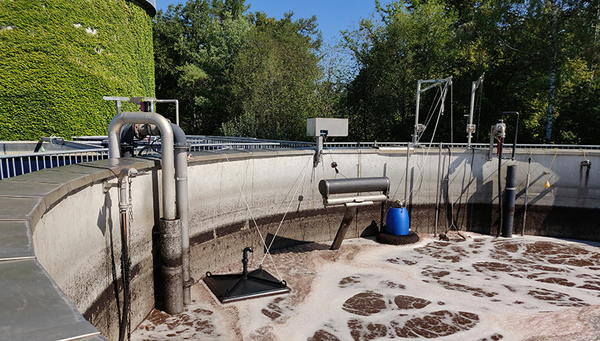News Detail
Wastewater treatment plants: On the trail of the climate pest nitrous oxide
April 11, 2023 |
Nitrous oxide is the third most important greenhouse gas after carbon dioxide and methane. Moreover, it is currently the main cause of destruction of the ozone layer. For a long time, the contribution of wastewater treatments plants to nitrous oxide emissions was greatly underestimated. Researchers at Eawag were recently able to demonstrate that around one fifth of all nitrous oxide emissions in Switzerland originate from wastewater treatment plants. It can escape in the biological cleaning stage as well as during treatment of sludge liquid and the incineration of sewage sludge.
Treatment of sludge liquid improves nitrogen removal
A team of experts from the Office of Waste, Water, Energy and Air of the Canton of Zurich (AWEL), together with Adriano Joss, group leader in the Process Engineering Department of the aquatic research institute Eawag, has now taken a closer look at the emissions from the treatment of sludge liquid. The treatment of sludge liquid with the anammox process has been introduced in a number of Swiss wastewater treatment plants in recent years in order to optimise nitrogen removal from wastewater and thus reduce the pollution of water bodies. In the anammox process, ammonium is converted with nitrite to elemental nitrogen, which is unproblematic and escapes into the air. Depending on the wastewater treatment plant, the process runs either in a single reactor or – in an optimised variant – in two separate reactors.
Since the specifications for nitrogen removal are to be tightened even further in the coming years, the number of wastewater treatment plants with treatment of sludge liquid will also increase. For this reason, the experts wanted to know in more detail whether this process releases relevant amounts of nitrous oxide and whether there are any differences between the one- and two-stage processes. To achieve this, they sampled the exhaust air from the treatment of sludge liquid in 12 Swiss wastewater treatment plants. In addition to these random samples, long-term measurements were also carried out at two of the plants.
The level of nitrous oxide emissions indicates treatment of exhaust air
The results recently published in the journal Aqua & Gas show that nitrous oxide emissions from the treatment of sludge liquid vary greatly over time. This means that a sufficiently high number of samples or measurements is needed over a longer period of time in order to make accurate statements. In the plants investigated in the study, emissions were similarly high in the one-step and two-step processes. Between 1.8 and 3.4 percent of the nitrogen contained in the sludge liquid was emitted as nitrous oxide. The treatment of sludge liquid thus contributes around 8 percent to the local greenhouse gas emissions of a wastewater treatment plant. From the experts’ point of view, these values indicate that the exhaust air should be treated to remove the nitrous oxide.
In a separate study, Adriano Joss therefore worked together with the company Infraconcept to clarify which technology would be suitable for exhaust air treatment. It became apparent that incineration of the exhaust air is the most suitable option – either through regenerative thermal oxidation or through co-incineration in a municipal waste or sludge incineration plant.
Cover picture: The black exhaust hood is used to take a sample of the exhaust air from the treatment of sludge liquid at WWTP Lake Thun in order to be able to determine the nitrous oxide emissions. (Photo: Christoph Dieziger, AWEL)
Original publication
Funding / Cooperations
- Eawag
- AWEL
- Infraconcept

